M. Isidora Forrest's Blog, page 23
July 25, 2021
Serving Isis: a responsibility to know and to experience
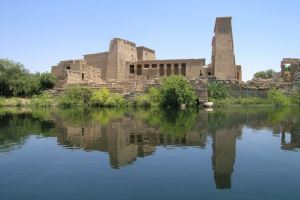 The Temple of Isis, a temple of learning; photo by Ivan Marcialis, Quartucciu, Italy; used under Wiki Creative Commons usage guidelines
The Temple of Isis, a temple of learning; photo by Ivan Marcialis, Quartucciu, Italy; used under Wiki Creative Commons usage guidelinesThere is a saying in the western esoteric initiatory tradition that seems particularly apt for the ministrant of Isis: “I desire to know in order that I may serve.” In means that we are not entering into our service simply because we’re greedy for secrets or status. It means that we seek knowledge so that we can better serve the Goddess, our communities, and our world.
Since ministerial service is essentially about giving, improving our own knowledge base and experience also means we will have something valuable to give.
KnowledgeOf course, those who serve the Goddess have always been expected to have some special knowledge, for example, knowing how to properly conduct the rites required to create and maintain a relationship with Isis. But this devotion to learning goes beyond that, too. The Greek philosopher, Porphyry, in his work On Abstinence, paraphrases the Stoic philosopher Chaeremon’s observations on the Egyptian priesthood:
“But they divided the night into the observation of the celestial bodies, and sometimes devoted a part of it to offices of purification; and they distributed the day into the worship of the Gods, according to which they celebrated them with hymns thrice or four times, viz. in the morning and evening, when the sun is at his meridian altitude, and when he is declining to the west. The rest of their time they devoted to arithmetical and geometrical speculations, always laboring to effect something, and to make some new discovery, and, in short, continually exercising their skill. In winter nights also they were occupied in the same employments, being vigilantly engaged in literary pursuits…”
Porphyry, On Abstinence, book 4, section 8
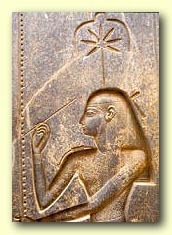 Seshat, Goddess of Wisdom, Knowledge, and Writing, shown with Her stylus
Seshat, Goddess of Wisdom, Knowledge, and Writing, shown with Her stylusThus, being a ministrant means not only knowing the proper rites, but also pursuing knowledge of all kinds, striving always to “make some new discovery.” There can be no doubt that teaching went on in the Egyptian temples. Of course, this was knowledge only for a very select group of people. Yet it informed the work of the priesthood so that they could be more effective in their service on behalf of Egypt and the people as a whole.
The Mysteries, such as the Mysteries of Isis or the Mysteries of Eleusis, were open to a wider group of people—as long as you could afford the travel and other expenses. Here, too, the officiants were expected to have special knowledge and understanding. Furthermore, they were expected to share that information with the initiates.
It was, in part, for this special knowledge that one undertook the Mystery rites. Initiates might expect the revelation of certain secrets regarding the Deities of the Mysteries. They might learn about new aspects of the Deities or be taught secrets of myth or ritual. Many would have been given important information about how to ensure a happy afterlife, as were Orphic initiates who were instructed on the proper spring from which to drink on their journey toward rebirth. In fact, it was quite commonly expected that the ritual guides of the Mysteries guided their clients to knowledge.
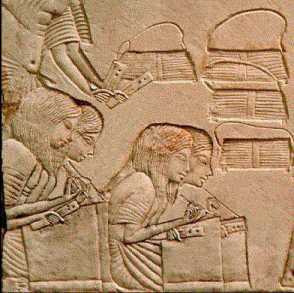 Young scribes learning their trade
Young scribes learning their tradeYou may recall that in Apuleius’ tale of initiation into the Mysteries of Isis, he was shown certain books (seemingly in hieroglyphs) that contained the instructions for his preparations for initiation. In fact, one of Isis’ late epithets is Lady of the Book. The aretalogy from Oxyrhynchus says that She was called ; and Isis has always been a Lady of Wisdom. Isis is a Goddess Who encourages learning and wisdom in Her devotees, and especially in Her ministrants.
Alas, modern Isiacs have no great temples in which to study or established Mysteries of our Goddess in which to serve.
As is our path in general, our course of study in Her honor must be more individualized. As one who serves Isis in this deeper capacity, there are things we should know. As far as it is possible, we should know the history of Her worship, how people honored Her in the past, what they thought and said about Her. That is one of the reasons I wrote Isis Magic. To be Her ministrant, I needed to know these things; and then, I needed to pass them on. That was one of Her tasks for me. Acquiring that knowledge formed a large part of my personal training. Even so, there is much Isis-related scholarship out there in the world and I still find out new things about Her and how people have related to Her throughout history. I try to share those new discoveries here on Isiopolis.
As a ministrant of Isis, you will likely be in a position to influence others. If you are teaching, you will need to know something in order to be able to teach it. As your students learn, you will have to continue learning so that you may always have something new to teach them. If we don’t keep on learning, we become dry vessels—not only for any thirsty students we may have the privilege to teach, but for ourselves as well. To keep our intellectual and spiritual juices flowing, we must keep learning.
And Experience May you experience Her holy wings
May you experience Her holy wingsBut “book learnin” is just one of the ways of knowing. The other is experience. This means we must develop our personal relationship with Isis; we must experience Her. This is a subtle kind of learning. It is different for each individual. And yet, there are commonalities. It is these subtle commonalities that let us know we’re connecting with Isis specifically.
This is even trickier when it comes to Isis because She is a Great Goddess. She has many, many aspects and different people may connect with different aspects. Still, there is a feeling commonality. I’m pretty sure that if you connected with Isis as Great Mother and I connected with Her as Great of Magic—and we could share each other’s feelings—as Her experienced ministrants, we would know that we were both experiencing Isis.
In the grand scheme of explaining things, that doesn’t help much, does it? Yet that’s what experience does. As a ministrant of Isis, you should be able to tell. On the other hand, we can’t let our experiential knowledge be used to deny someone else’s experience, even if we don’t agree with it, or to boost our own egos because we have the “right” answer. Our experience should be used to guide, and only with the permission of the guided (as in a teaching relationship).
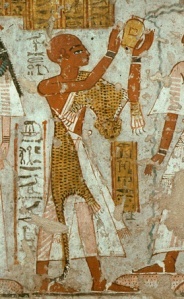 A priest purifying
A priest purifyingThe Pagan internet has been lit up in the last few years with a good deal of theological soul-searching about the nature of the Divine and our relationship to the Divine. It is very exciting that we have grown to the extent that it is time to have these discussions; I just wish we could have them without so many arguments.
Our experiences as devotees and as ministrant of Isis will lead us to find our own answers to these important questions. Our experiences can add value to the ongoing discussion about the nature of the Divine and our relationship with It. Our experiences may be used to guide others as they begin their own paths and until they find their own answers. But we must use our experiences wisely. Developing that wisdom is part of our Work as people who serve Isis.
July 18, 2021
What does it mean to serve the Goddess Isis?
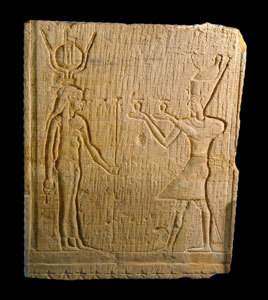 The pharaoh, as High Priest, makes offering to Isis
The pharaoh, as High Priest, makes offering to IsisWith a number of us gearing up to serve as ritualists in an upcoming Pacific Northwest Fall Equinox Festival, I’m re-running an older post on what it means to serve Isis as Her priest/ess. (Also, I’m scrambling to get the ritual written before our next Festival Crewe gathering, so bear with me.)
Of course, not all of our Festival ritualists will desire a relationship with Isis beyond the festival. Probably most won’t; they may already have important Divine connections in their lives. But for those who may, I offer these next few posts as starting thoughts for discovering a specific type of relationship with Her.
Oh, and another thing. As these are older posts, they used the gendered terms “priestess” and “priest.” As a community, we haven’t yet settled on a gender non-specific title for the intensely connected relationship with the Goddess that I will be talking about. So I’m going to try out a new one…and we’ll just see how that goes.
In ancient Egypt, the terms were very gendered; you really can’t get around that. One was either a Male Servant (hem) of the Goddess or one was a Female Servant (hemet) of the Goddess. So we’re not going to rely on ancient Egyptian terms, but English.
And now, here’s the older post with updates…
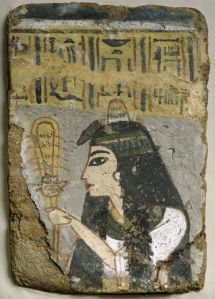 A Servant of the Goddess shakes the sistrum to please Isis
A Servant of the Goddess shakes the sistrum to please IsisOf course, we can all have a deeply meaningful personal relationship with the Deity or Deities of our choice in whatever capacity we choose. But being a ministrant of the Deity is a particular kind of relationship; a particularly worthwhile one if you find yourself attracted to Isis.
If you already serve a specific Deity, you have likely already done some thinking on this topic. If not yet, you may decide, sometime in the future, that you’d like to have a deeper, more formal relationship with Isis as Her ministrant.
But what does it mean to serve Isis in this way? The easy answer is that it means different things to different people. The more difficult, and truer, answer is that we each have to figure out for ourselves what it means to us.
So how do we do that?
A good place to start is with what it has meant to serve the Goddess in this intensely connected manner. So over the next few posts, we’ll talk about some of the things we know about ancient Servants of Isis as well as some of the ways we can discover for ourselves what being Her ministrant may mean to us today.
Key #1: Serving the GoddessService has been part of a ministrant’s job description as far back as we know. In one sense “one who serves” is the very definition of this role. This is true of our English word “minister.” To minister is to serve and, as you can see, it is the basis of the non-gender-specific word I’m trying out here. Generally, a ministrant’s service goes two ways: to the Divine and to the greater circle of worshippers.
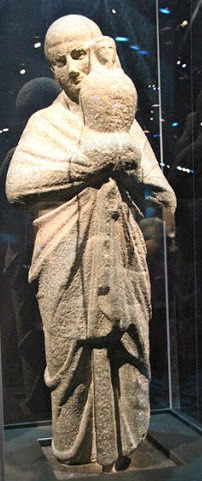 A priest of Isis carries a sacred vessel in veiled hands
A priest of Isis carries a sacred vessel in veiled handsFor people in mainstream religions, which have very prescribed ways to serve, things are—in at least this way—easier. For example, if you are a Catholic priest (you can’t be a Catholic priestess), you would have a very clear idea of what it meant in your particular religion to “serve God.” You would have gone through specific training meant to teach you precisely this.
Having precise ways to serve was true in ancient temples of Isis, too. Besides the upkeep and maintenance of the temple complex, there were particular ritual acts that had to be performed every day; for example, opening the shrine of the sacred image of Isis each morning and “putting Her to bed” each night. And of course, there were offerings to be made, festivals to be celebrated, and funerals to conduct. A ministrant of Isis might play the role of the Goddess in certain rituals. The Servants of Isis would learn the words to the sacred songs and invocations and how to perform them properly in the rites. Some served as sacred musicians.
 A priestess carries a sacred vessel in veiled hands
A priestess carries a sacred vessel in veiled handsBut this type of formal structure of service is not available to us today. In a non-mainstream, more informal type of spirituality—such as those of the modern Pagan-Polytheist-Wiccan-Witch-insert-your-identifier-of-choice-here communities—things are less clear. It means that this path, if truly and deeply followed, is more difficult than those of mainstream religions because we have to blaze our own trail. It also requires a significant degree of perseverance and self-honesty to be able to make the important decisions that we must make when creating a personal path.
To take this alternative path, we need perseverance because we will not always know which branch of the path to take…or it will be dark…or it will even be boring. We need self-honesty because we often walk this path alone. And walking alone, with no one to consult, we can sometimes take a wrong turn. We can delude ourselves into not seeing things about ourselves or a situation that we should be seeing.
On the other hand, this path can be extremely rewarding precisely because it is difficult. Whereas in mainstream religions there tend to be established answers to the Great Questions, we must find our own answers—fresh and new every time. What happens after death? What does it mean to serve Isis? Why is there evil in the world? What is the nature of reality? What is the nature of humanity? What is the nature of the Divine?
All these are important questions that spiritual people have tried to answer from the beginning of time, and for which we still seek answers today. It is worth our time, as lovers of Isis, to seek our own answers to these questions.
 Roman sacerdotes of Isis in sacred procession
Roman sacerdotes of Isis in sacred processionSome will define service as “doing Goddess’ will on earth.” That’s a valuable insight; but how do you know if you’re doing Her will? Is it as simple as listening to your inner voice? Perhaps. Yet how do you know you’re hearing correctly and not coloring it with your own personal psychology or desires? I can tell you for a fact, it will ALWAYS be colored by your own personal psychology and desires. That’s not a disaster; it just brings us back to that self-honesty thing.
So how do you get around yourself? Discovering how to do that is part of the work of a ministrant of Isis. For some, it may be the key part. So I’m going to come back and talk about this some more when I come to the topic of personal spiritual development in a later post. For now, back to service.
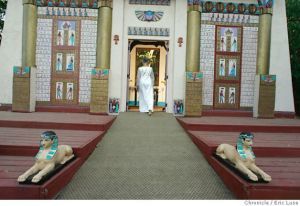 A modern Isian enters the temple at Isis Oasis
A modern Isian enters the temple at Isis OasisWhat about the other kind of service—service to the greater circle of worshippers?
You’ll find a wide variety of expressions of service in this area. Some ministrants are always available to help those in their circle, whether with spiritual or personal problems. Some take the responsibility of organizing a circle and keeping it running as their service, but don’t expect to be called on the solve personal problems. Some represent their tradition to the greater Pagan community by organizing large festivals. Some organize or moderate blog communities. Some teach. Some don’t.
Again, it is a personal decision as to how you might decide to serve. Yet I do think that we are obligated to do some service of this type. By serving other people in these ways, we acknowledge the importance—the value—of other people. By serving people, we integrate this knowledge in a deep, intimate, and personal way. (I hear some of you moaning right now. People are SO difficult. Yes. Yes, they are. And complicated. You bet they are. But they are also very worth your time and care. So very, very worth it.)
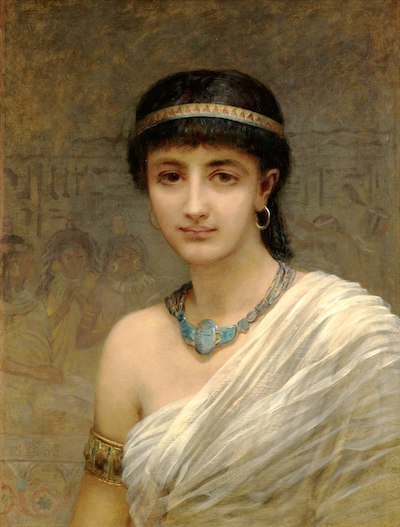 Edwin Long, “A Votary of Isis”
Edwin Long, “A Votary of Isis”The same is true of service to others who are not a part of your circle; humanity as a whole. Many religions—most religions, actually—place value on helping those in need. Feeding the hungry. Clothing the cold. Sheltering those without shelter. This sort of service is appropriate for the ministrant of Isis as well. Caring in this way makes us aware of other people and their needs and problems. It encourages our compassion and discourages our ego-centered-ness. At the very least a Servant of Isis should give money to charity—anonymously, if possible. Do other good deeds. Help people. Help the earth. And be aware of doing whatever it is you are doing in the spirit of service—with an open, compassionate heart. In this, we do our best to imitate the compassion of Isis Herself when She healed the child of the woman who refused Her shelter or withdrew the spear from Set even as He threatened Her own son, Horus.
Ultimately, serving others makes this world a better place one person at a time. Spread kindness and you will serve Isis.
Next Time, Key #2: A Responsibility to Gain Knowledge & Experience __ATA.cmd.push(function() { __ATA.initDynamicSlot({ id: 'atatags-26942-60f4910b034b6', location: 120, formFactor: '001', label: { text: 'Advertisements', }, creative: { reportAd: { text: 'Report this ad', }, privacySettings: { text: 'Privacy', } } }); });July 11, 2021
Offering to Isis: Fall EQ 2021
Yes!
The Pacific Northwest is ON for an Isis-themed Fall Equinox Festival (Sept. 24-26, 2021). This is not the same festival we were planning for 2020. That one was much more…involved…shall we say. This one is a gentle way of coming together once again as a community. So I’d like to share with you the write up for the festival, then I’ll repost something on Making Offering in the Egyptian way that will be related…
 Frederick Arthur Bridgman, A Procession in Honor of Isis or An Egyptian Procession, 1902
Frederick Arthur Bridgman, A Procession in Honor of Isis or An Egyptian Procession, 1902Offering to Isis: A Fall Equinox Celebration of the Goddess and of Community
If you asked the ancient Egyptians, the act of Making Offering was one of the things that maintained Ma’et, that which is Right and True. Offering helped keep the world in balance. Making Offering is part of the great reciprocal flow between the Divine and the human. It is one of the most important ways we communicate with our Goddesses and Gods. It is hallowed by tradition. It is empowered by magic.
As we turn the wheel at this Fall Equinox, let us come together in rituals of offering. Under the Wings of the Great Goddess Isis, let us gather in a celebration of our reentry into and reconnection with Community. In the presence of the Isis Myrionymos, Myriad-Named Isis, Goddess of the Ten Thousand Names, let us gather with open hearts and generous spirits to Make Offering.
As we human beings have always done—from the First Time, the Zep Tepi—we shall give gifts to Isis and we shall receive gifts from Her.
 “My body being on earth, my heart being awakened, my magic being in my mouth, O Isis, I Make Offering unto You.”
“My body being on earth, my heart being awakened, my magic being in my mouth, O Isis, I Make Offering unto You.”We are living through extraordinary times. Many of us have gone through intense changes. There have been painful losses. And there have been surprising gains. Through Rites of Offering, we can give thanks, mourn losses, and ask for aid. We can find Divine connection and reawaken our hearts.
The Rites of Offering
Our rituals are inspired by the Daily Offering Rites worked in ancient Egyptian temples. We will come together four times, at the cross-quarters of the Holy Day and Sacred Night, to Make Offering to the Goddess in four of Her myriad names.
Yet, as a Community, we are many different people, on many different paths, who honor many different Deities. And so the Iset Weret— the Great Throne Altar of Isis—will welcome all our Divine Ones. If you wish, you are invited to bring an image or symbol of your own Divine One/s to add to the Great Altar that They may receive Offering as well.
 We’ve missed each other!
We’ve missed each other!Now, Let’s Celebrate
This festival is intended to give us plenty of open time so that we can be together…for feasting, drumming, dancing, and just relaxing. No formal workshops are planned.

Come join us in this Fall Equinox celebration as, under the Wings of Isis, we come together as a Community once more.
Now here’s a little something about Making Offering…
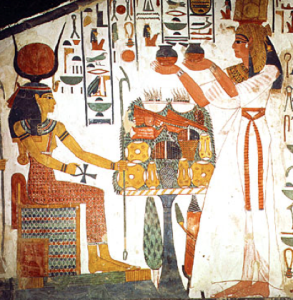 Nefertari makes offering to Isis
Nefertari makes offering to Isis****************************************
Can Isis smell the flowers we place upon Her altar? Does She eat the delicacies we so carefully arrange upon Her offering mat? Does She drink the wine we pour into a beautiful cup and lift to the smiling lips of our sacred image?
Well, no.
And, yes.
Although I have had weird phenomena happen with offerings—for instance, once an entire two-ounce packet of incense (you DO know how much two ounces of powdered incense is, right?) was apparently incinerated without leaving a whiff of scent in the air of our tiny temple space—usually, the flowers wither naturally, the food dries to inedibility, and the wine evaporates.
So did the Goddess receive Her offerings or not?
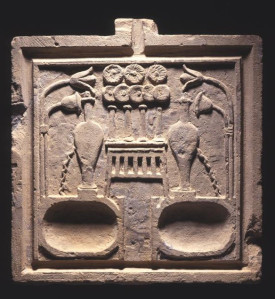 An ancient Egyptian offering table
An ancient Egyptian offering tableFor the ancient Egyptians, the sacred images of the Deities were sacred precisely because they were filled with some measure of the Deity Her- or Himself. Offerings to Isis were received by this bit of the Goddess residing in the image, and through it to Her greater Being.
The main spiritual mechanism for the transfer of an offering from offerent to Deity was the ka, or vital, life energy. All living beings—Deities, human beings, animals, fish, plants, stars, mountains, temples—have a ka. The kas of the Goddesses and Gods are extremely powerful. In one Egyptian creation myth, the Creator Atum embraces His children, the God Shu and the Goddess Tefnut, with His ka in order to protect Them from the primordial chaos of the Nun into which They were born—and, importantly, to transfer His ka to Them, giving Them life. Ka energy exists before a being comes to birth, is joined to that being at birth, lives with her or him throughout life, then travels to the Otherworld after death. The tomb became known as the Place of the Ka (among many other designations) and to die was to “go to one’s ka.”
 King Hor’s ka statue; beautiful and haunting
King Hor’s ka statue; beautiful and hauntingThe ka “doubles” the person physically, yet the ka is not essentially personal. It is held in common with all living things—including the Deities. The ka was the ancient Egyptian’s connection to a vast pool of vitality greater than the individual person.
But that’s not the end of it. One meets one’s ka after death where it can continue to protect.
Utterance 25 of the Pyramid Texts says that the dead king “goes with his ka.” Just as a list of Deities “go with Their kas,” so does the king:
“You yourself also go with your ka.
O Unas, the arm of your ka is before you.
O Unas, the arm of your ka is behind you.
O Unas, the leg of your ka is before you.
O Unas, the leg of your ka is behind you.”
 A ka statue of Amenemhet III
A ka statue of Amenemhet IIIYou might recognize this formulation. It is a common magical formula for invoking protection on all sides; similar to casting a circle or the Lesser Banishing Ritual of the Pentagram or part of the so-called Breastplate of St. Patrick (“Christ at my right. Christ at my left, etc.”)
Even though ancient Egyptians could experience the ka as separate from themselves, the ka also connected the person with the long line of humanity—for the ka was associated with the ancestors. In fact, the ancestors were thought to be the keepers of ka energy. Jeremy Nadler suggests that when people died, the Egyptians believed that they returned to the ka-group of ancestral energy to which each person naturally belonged. In other words, after death, the ka returns to its family.
This meant the living had several reasons for making offering to their ancestral dead. As we all do, they wanted to remember loved ones who had died. The offerings provided their ancestor’s kas with the nourishment required to keep the family spirit strong. But since the ancestors had ready access to the greater pool of beneficial ka energy and could bestow it on the living, people could also ask their ancestors to send them a blessing. A blessing of ka energy could nourish human beings, animals, and crops alike.
As usual in Egyptian society, the king was a special case. He could have multiple kas. He also had more intimate contact with the powerful ka energy of his royal ancestors than the average person had with their familial kas. The royal ka was especially connected with the power of the God Horus. By the time of the New Kingdom, the king’s ka was specifically identified as Harsiese, “Horus, son of Isis.”
 Modern Balinese food offerings that look remarkably Egyptian
Modern Balinese food offerings that look remarkably EgyptianIn Egyptian, the word ka is related to numerous words that share its root. Egyptian words for thought, speech, copulation, vagina, testicles, to be pregnant and to impregnate, as well as the Egyptian word for magic (heka), all share the ka root. And all have some bearing on the meaning of ka. Ka is also specifically the word for “bull” and “food.” Connections such as these reveal mysteries. Ka is also the bull because it is a potent, fertile energy that contains the ancestral seeds that connect us with our families. Ka is also food for it is the energy that nourishes life, in both the physical and the spiritual realms. Ka is intimately connected with offering; the plural of ka, kau, was used to mean “food offerings.” Sometimes the ka hieroglyph replaces the images of food inscribed on offering tables.
 Offering table piled high with kau and other offerings
Offering table piled high with kau and other offeringsKau, food offerings, provide life-energy for the individual ka. When the Egyptians offered food to their Deities or honored dead, they were offering the ka energy of the food to the ka of the Deities or ancestors. The ka inherent in the kau nourished the ka of the spirit being. Offering thus feeds the kas of the Deities and ancestors and the great pool of ka energy to which all enlivened things are connected. Simultaneously, the great pool of ka energy is the source of the energy found in the offerings by virtue of the ongoing, archetypal connection with it. By making and receiving offering, a great reciprocal power system was set up and could be eternally maintained. No energy was ever lost; it was continually transformed and re-activated by being offered and received, received and offered. Ka energy may be considered the food that fuels the engine of the living universe.
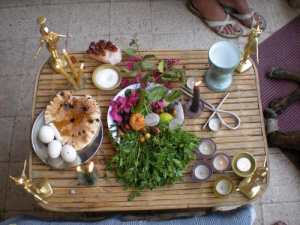 A modern offering table
A modern offering tableSince offerings are given and received ka to ka, it is no wonder that the Egyptians who made offering before the sacred images in the temples, did not expect the Deity to physically consume the food or drink offered. Instead, they expected the Deity’s ka, residing within the image, to take in the energy from the kas of the offerings. Ancient texts are explicit about this. A text from Abydos says that the pure, Divine offerings are given daily “to the kas” of the temple Deities. Sometimes the Deities are said to have been “united” with Their offerings. It is the ka of the offering and the ka of the Deity that unite. In another text from Abydos, the king asks the Deity to bring His magic, soul, power, and honor to the offering meal. Clearly, the king is not expecting a physical appearance, but a spiritual one.
It is the same with our offerings. We offer the ka of the kau to Isis and Her ka receives it. We can open our awareness to this aspect of offering by envisioning the ka, perhaps as Light, move from the offering to our sacred image of Isis (if we are using one) or to an image of Her we hold in our mind’s eye. In this way, we can know that Isis has indeed received what we offer to Her.
__ATA.cmd.push(function() { __ATA.initDynamicSlot({ id: 'atatags-26942-60eb790c011d8', location: 120, formFactor: '001', label: { text: 'Advertisements', }, creative: { reportAd: { text: 'Report this ad', }, privacySettings: { text: 'Privacy', } } }); });July 4, 2021
Isis the Ass-Kicker
 My sacred image of the Goddess in Her Wadj (Green) Temple
My sacred image of the Goddess in Her Wadj (Green) TempleA little while ago, I had the opportunity to be in the same room with several other priestesses of Isis and we were talking about Her (as priestesses of Isis are wont to do).
All of us agreed with this statement: “Isis will kick your ass.” And each of us knew exactly what the others meant by that.
We had all experienced it, you see.
But just in case you haven’t yet had the opportunity to have your own sweet butt kicked by the Goddess, I’ll explain.
 She insists…
She insists…When you undertake a relationship with Isis, whether that be as a priestess, priest, or devotee, it is more than likely that She will ask something of you. For instance, She might want you to get your physical surroundings in order so that you can create a temple space for yourself. She might want you to quit smoking. She might want you to start a group to teach Her Mysteries. She might want you to create a ritual or a work of art. She might ask you to volunteer at a homeless center. She might insist you learn something particular—or finally see a doctor about that issue you’ve been having.
In my case, She wanted me to write for Her.
Now, I say, “She might want,” but what I really mean is, “She will demand.” Not in a whiny, naggy way, but in an insistent, just-keep-bringing-it-up-to-you way. Like a good mother teaching Her child, the Goddess makes sure that Her request just kinda seems to be in your face all the time…until you do it, or at least until you get started on it.
 You remember that thing we were talking about? Well?
You remember that thing we were talking about? Well?But that’s just the surface stuff.
The real ass kicking is what happens as you actually undertake your mission from the Goddess.
You grow—and growth can sometimes be painful. What Isis asks you to do usually has some value in terms of your earthly life (a cleaner house, cleaner lungs), but the secret is that this particular task has also been chosen by Her to help you grow spiritually. This means that it will usually bring up some soul issues (psychology is the study of the soul; you knew that, right?) that you need to deal with in order to be a competent priestess, priest, or devotee.
 Lovingly, insistently, persistently, She will help you grow. Please present butt.
Lovingly, insistently, persistently, She will help you grow. Please present butt.And while you’re trying to deal with those little tender spots in your psyche, She will also demand of you complete honesty. Honesty with yourself. You must accept your part in your own problems; and you must accept your greater part in the solution. There’s no hiding, no blaming other people, no whining. (Well, you might whine a little and, in that case, She will always, always comfort you.) This combination of Divine persistence and motherly comfort and kindness creates the space for each of us to truly grow in Her presence.
Personally, I’ve never been sorry when She kicked my ass. I think the priestesses with whom I spoke the other night would agree. How about you?
June 27, 2021
“Doing Things” for Isis
 This is concept art from Exodus; an imagined Egyptian royal palace. It looks hot, like it is in Portland right now.
This is concept art from Exodus; an imagined Egyptian royal palace. It looks hot, like it is in Portland right now.Those of you who have been following this blog for a while may be familiar with my small rants about The Old Gentlemen of Egyptology and their innate sexist attitudes. Well, today it’s time for another rant…just a little one…but this time it’s about the Even Older Gentlemen of Ancient Egypt and their innate sexist attitudes.
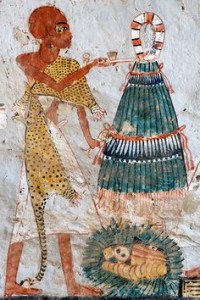 A Sem priest…Doing Things
A Sem priest…Doing ThingsYou see, I just came across a scholarly article by Carolyn Routledge entitled “Did Women ‘Do Things’ in Ancient Egypt? (c. 2600-1050 BCE)” at the same time as Academia.edu served me up a thesis by the same Carolyn Routledge about ancient Egyptian ritual practice, which was an in-depth study of two specific words having to do with ritual, one of which translates as “doing things” (iri ḫt).
Routledge explains that the Egyptians used ir ḫt (“to do things”) in several specific ways. In addition to its meaning as ritual performance, including funerary rites, it also has to do with the performance of work or duty, and even negative behavior. It was used particularly in relation to physical activity.
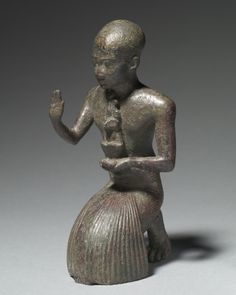 A priest making a ritual gesture…part of Doing Things. In this case, he is probably offering the object in his left hand while making a right-handed gesture to honor the Deity.
A priest making a ritual gesture…part of Doing Things. In this case, he is probably offering the object in his left hand while making a right-handed gesture to honor the Deity.Of course I’m most interested in ir ḫt meaning “to do ritual.” The kinds of ritual activities that were Done included libating and censing and making offering: “you perform rites [iri ḫt]; bread, beer, and incense upon the flame.”
Interestingly, there also seems to be some emphasis on doing these things with one’s arms and hands. Makes me wonder whether, in addition to the sheer physicality of using a sacred vessel to libate, a censer to burn incense, or employing some other ritual object, there was also supposed to have been an accompanying gesture. There also seems to have been a connection to written instructions in the performance of ritual. So the lector priest, the sacred reader, was one who definitely Did Things.
 Lector priest and Sem priest, Doing Things
Lector priest and Sem priest, Doing ThingsIf one wanted to be quite specific, one could also say he was iri ḫt nṯr, “doing God’s rites” or iri ḫt nṯrt, “doing Goddess’ rites.” But notice that pronoun I just used in relation to the person doing the Doing? Yeah. He. Sadly, Routledge answers the question posed in her article title with a resounding no; women did not Do Things. At least as far as we can tell from the evidence left to us, and I must admit it seems reasonably conclusive.
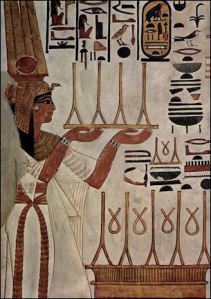 A queen…obviously not Doing Things; from the tomb of Nefertari
A queen…obviously not Doing Things; from the tomb of NefertariFor example, the king has the title, neb ir ḫt, “Lord of Doing Things.” It is often used in connection with the king Doing Things that maintain Ma’et, including cultic functions as well as kingly duties and activities. The queen, however, does not Do Things. She has no title, Lady of Doing Things. Instead, she “says all things and it is done for her.” I used to think that was a nice expression of queenly power; now, I’m kinda thinking it’s the opposite: an expression of the perceived inability of women to Do Things themselves.
There are only two exceptions: Sobeknefru and Hatshepsut, both women who ruled as king, not queen. In Hatshepsut’s case, about half of the references to that title are in the masculine form, half in a feminized form: nebet ir ḫt. (We have no references to Tausert, a later woman ruler, having that title.)
The exclusion of women from Doing Things is, of course, the basis of my rant. Or maybe it’s not even really a rant. More of a whine. Or an exhausted, put-upon sigh.
 Clearly, she is not Doing Things
Clearly, she is not Doing ThingsThe king, priests, and officials of all stripes Did Things. But when it came to women, the “things” part of the important phrase was avoided. There are instances of women iri irw, “doing doings” or “performing performances,” but not iri ḫt. Routledge gives an interesting example of a husband and wife, both named Djehutynakht, both with the same funerary text on their coffins, but hers excludes the word ḫt.
It’s practically impossible not to smell the old sexist weakness-of-women, unfitness-of-women-for-important-stuff stereotypes here. But we don’t know. Routledge suggests that it may be because iri ḫt was associated with educated, literate, and highly trained people, very few of whom would have been women in ancient Egypt. True enough. But the question underlying that conclusion is “why not?” Which, of course, refers us back to the first sentence in this paragraph.
 People Doing Things and Not Doing Things in the afterlife
People Doing Things and Not Doing Things in the afterlifeSo what can we do with this information? Why am I sharing it with you?
First, I enjoyed learning an important ancient term for doing ritual and reading about its specific connotations. Second, we sometimes tend to idealize the ancient Egyptians—we do so love their Deities, their art, their magic and mysterious ancient wisdom. It is important to know that every society—theirs, ours, everybody’s—has flaws, often significant ones, and we should not be blind to them. And in our own case today, we must work to fix them.
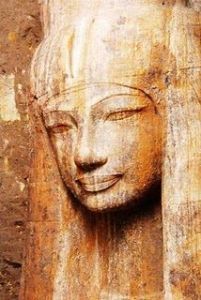 An image of Queen Tjye recently found at Luxor; pretty sure this woman could Do Things
An image of Queen Tjye recently found at Luxor; pretty sure this woman could Do ThingsAnd third? Third, I hope to encourage all of us to Do Things for Isis. We all have the capacity for Doing Things in the ancient sense: with power, purpose, and effectiveness. Let us also be reminded that the physicality of ritual is important. For when we are fully engaged with what we are Doing—body, mind, soul, and spirit—ritual is far from being empty show. It is instead Right Action that can truly Open the Ways so that we may come, once more, to the Divine Heart of Isis.
June 20, 2021
Becoming Joined to Your Star
Perhaps it was coincidence or perhaps it was the hand of Isis, but twice in the past week, the idea of “being joined to one’s star” has been brought sharply to my attention. So today, let’s talk a bit of the Way of the Stars…and especially the way of our own personal star.
 Nuet, Full of Stars
Nuet, Full of StarsIn Isis Magic, the Path of the Stars is the path of the Prophetess or Prophet of Isis. (In Egyptian, this would be Hem/et Nutjeret; the Servant of the Goddess.)
 Photoshop; but beautiful
Photoshop; but beautifulOn this path, we deal with the important star Sirius (Sothis in Greek, Sopdet in Egyptian), which is the Star of Isis. The Goddess Herself may be seen in the star and sometimes the star is said to be the ba, the manifestation or soul, of the Goddess
We honor Isis in Her singular and beautiful star, but on the Path of Stars, we also work with the idea of a universe filled with millions and millions of stars—stars that are, like us, within the body of Nuet, the Sky Goddess and Mother of Isis.
In the Pyramid Texts, it is clear that the deceased king ascends to the heavens and becomes a star. This ascension also makes him Divine, a god among Gods. He takes his place in the otherworld as a star, sometimes called the Lone Star or the Morning Star.
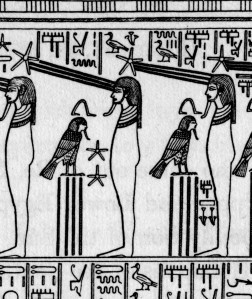 An image from one of the shrines of Tutankhamon; these mummified Gods are joined to their stars and “receive the rays of Re”
An image from one of the shrines of Tutankhamon; these mummified Gods are joined to their stars and “receive the rays of Re”In Utterance 245 of the Pyramid Texts, the Sky Goddess says to the deceased, “Open up your place in the sky among the stars of the sky, for you are the Lone Star, the companion of Hu…” (Hu is one of the great creative powers of Re, “Creative Utterance.” It may be that the Goddess is likening the king to Sia, “Perception,” for indeed he specifically declares himself to be Sia in Utterance 250.) Utterance 248 reiterates the king’s star-nature. He is “a star brilliant and far traveling,” and he has “come to his throne which is upon the Two Ladies [Isis and Nephthys or Wadjet and Nekhbet] and the king appears as a star.” A text from the tomb of Basa, a priest of Min and mayor of ancient Thebes, says of the deceased, “your star be in heaven, your ba upon the earth.”
While the Pyramid Texts are concerned with the king, as time went on, the Egyptian conception of the otherworld got more democratic; everyone could participate and have their own Divine stars.
But if you’ve read any of the Pyramid or Coffin Texts or the Book of the Dead, you’ll know that those sacred texts are not intended just for the dead. The texts tell us that the knowledge they impart is also beneficial for living human beings. “As for him who knows this spell on earth . . . he will proceed to a very happy old age” says one text. Another states that anyone who knows the spell will “complete 110 years of life,” while yet another explains, “it is beneficial for anyone who does it.”
 This is an image I took of the same scene from a reproduction of Tut’s shrine that came through town pre-pandemic
This is an image I took of the same scene from a reproduction of Tut’s shrine that came through town pre-pandemicThe same thing applies to being conscious of or joined to your star. It is not solely a post mortum activity. If our “star” is our Divine Self, the one we will hopefully become after death, then to know our star in this life means that its light can serve as a guide as we move through our current earthly lives. What would my star self do in any given situation?
One of the Greco-Egyptian magical papyri even has a specific ritual for learning about “your star,” and which is referred to as “an initiation.” There are quite a number of preparations, but in short, you purify yourself for seven days while the moon is waning. On the night of the dark moon, you begin sleeping on the ground each night for seven nights, waking every morning to greet the sun and to name the Deities of the hours of the day. On the eighth night, you rise in the middle of the night, perform a series of invocations and magical acts, recite the account of creation, and call upon the Great God. When the God arrives, you avoid looking in His face and ask Him about your fate. “He will tell you even about your star and what kind of daimon [spirit] you have…” (PGM XIII 646-734)
 We, the many stars in Her heaven
We, the many stars in Her heavenIt is well for us to know “even about our star.” For it illuminates the individual life and spiritual path that is uniquely ours, but it also places us in the company of the Divine Ones.
I did a meditation, not too long ago, about the Child Horus in the stillness of the womb of Isis. It came to me that it may be there and then that we are first joined to our stars. But to truly benefit from this starry relationship throughout our lives, we must continually renew, strengthen, and deepen the connection so that our star’s holy light may always inspire and guide us.
We might think of our star as our Star Self or Isis Self. But, like the Goddess Herself, it has many other names as well. It can be called the Higher Self, the Augoeides (“Shining One”), the Holy Guardian Angel, the Higher and Divine Genius, Christ Consciousness, the Atman, the True Self, the Inner Teacher, and many more. And when we are joined to it, we will be our truer and more divine selves.
__ATA.cmd.push(function() { __ATA.initDynamicSlot({ id: 'atatags-26942-60cf704f71ed2', location: 120, formFactor: '001', label: { text: 'Advertisements', }, creative: { reportAd: { text: 'Report this ad', }, privacySettings: { text: 'Privacy', } } }); });June 13, 2021
Isis the Scorpion
 An ancient Egyptian representation of a scorpion
An ancient Egyptian representation of a scorpionA friend living in the desert told me she’d been stung by a scorpion and that, in her words, “it royally sucked.” No doubt. The ancient Egyptians, as you may know, had the same problem…and often with much more poisonous scorpions than the one that got my friend.
Since much of Egypt is dry desert, it has plenty of scorpions to go around. It’s true today just as it was in ancient times. In fact, the danger of scorpion sting was ever-present; and because scorpions are smaller and harder to spot, the chance of getting stung by a scorpion outweighed that of snakebite.
Whether an Egyptian’s experience of scorpion sting merely royally sucked or took them to the afterlife depended on which scorpion did the stinging as well as the size and health of the victim. For instance, one of the most poisonous scorpions in the world, the Palestine Yellow—aka The Deathstalker—is found in Egypt today. Luckily, it is small and cannot deliver enough poison to kill an adult, though that has happened.
 The cat-scorpion problem, illustrated
The cat-scorpion problem, illustratedOn the other hand, scorpions were a lethal threat to children, as well as to pets, especially cats. Picture a scorpion with its scuttling movement and raised and waving tail and you’ve pretty much got an irresistible cat toy.
Not surprisingly, we have a number of ancient Egyptian healing spells against scorpion sting, including this heart-rending one for a pet cat:
O Re, come to Your daughter for a scorpion has stung her on a lonely road! Her cries have reached heaven. Come to Your daughter! The poison has entered her body and it has spread in her flesh. She has put her mouth to the ground, See, the poison has entered her body! Do come with Your power, and Your rage, with your wrath! See, it is concealed from You, now that it has entered the whole body of this cat under my fingers…”
The rest of the formula has Re come to save His daughter, the cat, by identifying the various parts of her body with the Deities. (This is the same formula that was often used for human beings, by the way.) At the end of the formula, Isis and Nephthys join in the healing and weave Their protection: “Isis has spun and Nephthys has woven against the poison.”
 Serket, “She Who Causes the Throat to Breathe”
Serket, “She Who Causes the Throat to Breathe”Yes, of course, we have to circle around to Isis, for Isis is a formidable Scorpion Goddess Herself. In this guise, She is called Iset Ta-Wahaet, Isis the Scorpion. In other texts, Isis is joined with Serket Hetyt, the Scorpion Goddess, “She Who Causes the Throat to Breathe,” as Isis-Serket. (It is interesting to note that, since scorpion venom is a neurotoxin, death from a scorpion sting is by asphyxiation, that is, suffocating.)
At Isis’ sanctuary at Koptos, it was said that during the time when the women ritually lamented with the Goddess, they could walk through a mass of scorpions unharmed. Late legend had it that scorpions would refuse to sting any woman—or any worshipper of Isis, for that matter—out of respect for the Goddess.
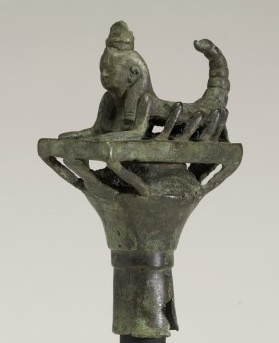 An image of Isis-Serket in the Walters Art Museum in Baltimore, MD. An inscription that says, “Isis may give life” is preserved. (I wonder if it isn’t “May Isis give life”?)
An image of Isis-Serket in the Walters Art Museum in Baltimore, MD. An inscription that says, “Isis may give life” is preserved. (I wonder if it isn’t “May Isis give life”?)Scorpions are the faithful companions, protectors, and guides of Isis in one of Her most famous myths.
In the tale, Isis is fleeing in an attempt to hide Her newborn child, Horus, from Set. Seven magical scorpions accompany her. In what smacks of a ritual formula, we are told that the scorpions Tefen and Befen walked behind Isis. On Her right was Mestet, on Her left, Mestetef. Before Her walk Petet, Thetet and Maatet.
Upon reaching a city at the edge of the papyrus swamps, Isis found She was weary and approached the home of the chief woman of the district for shelter. But seeing the scorpions, the woman was afraid and angry that anyone would dare approach her home with these dangerous creatures. She refused the Goddess. The scorpions became angry at the rejection and vowed revenge. While Isis found refuge with a poor woman, the scorpions gathered all their poison together and placed it in the tail of Tefen. Tefen entered the home of the chief woman and stung her young son who fell instantly from the terrible poison. But Isis took pity on the child and cured him. At this, the chief woman was ashamed of her behavior and filled the home of the poor woman who had sheltered the Goddess with beautiful gifts from her very own home.
 This is a Canadian theatre group that does opera for kids. They made a show about Isis & the Scorpions.
This is a Canadian theatre group that does opera for kids. They made a show about Isis & the Scorpions.This story about the seven scorpions and Isis is, in fact, from a healing spell to cure a scorpion sting. In another tale—also from a healing formula—the son of Isis, Horus the Child, is stung by Set in the form of a scorpion. Isis stops the Boat of the Sun in the sky so that Thoth can come down and cure the child. (It may seem odd that Isis Herself could not cure Horus, since it is She Who is called upon in other scorpion spells to do the healing—but that’s the story and I’m sticking to it. Perhaps additional magic was needed because this was no ordinary scorpion, but Set in disguise.)
Right after this story is another spell for healing a scorpion sting using seven magical knots (perhaps alluding to the seven Isiac scorpions?), and following that another one in which Isis invokes Re to heal a scorpion-stung Horus. Parts of that formula sound very much like the language used in the story of “Isis and Re” in which Isis cures Re of snakebite. There are also formulae in which Horus is the one Who cures the scorpion sting. There are yet others that are spoken to stop the scorpion from coming near by blocking or enwrapping it. I love this line from one of those spells:
A very small thing, a sister of the snake is the scorpion, a sister of Apophis [the great Enemy Serpent], sitting at a crossroads, lying in wait for someone who goes in the night, who goes in the night…
 Isis and the Black Scorpion comic book
Isis and the Black Scorpion comic bookThe association of Isis with the scorpion reaches far beyond ancient Egypt. Athanasius Kircher, a 17th century Jesuit scholar and philosopher, called the constellation of Scorpio “the Station of Isis” and identified the brightest star in Scorpio, the red star Antares, with the Goddess. According to a turn-of-the-century star guide by Richard Hinkley Allen, Antares was originally associated with the Scorpion Goddess, Serket.
Oh, and there’s an Isis comic book in which Isis teams up with The Black Scorpion, another female superhero, so the two Goddesses continue to be linked even in modern mythology.
__ATA.cmd.push(function() { __ATA.initDynamicSlot({ id: 'atatags-26942-60c674a11bab8', location: 120, formFactor: '001', label: { text: 'Advertisements', }, creative: { reportAd: { text: 'Report this ad', }, privacySettings: { text: 'Privacy', } } }); });June 6, 2021
The Keeper of the Pharos Lighthouse
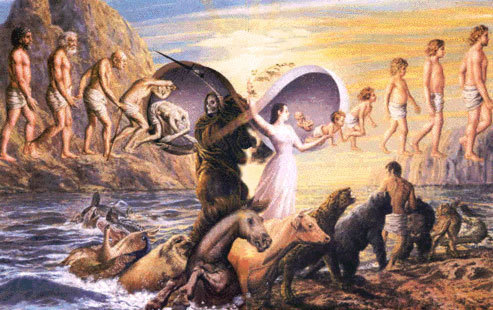 An artist’s depiction of reincarnation
An artist’s depiction of reincarnationI don’t know whether I believe in reincarnation; at least in the usual contemporary sense. Oh, I like the idea of it…and it’s quite true that there are some amazing stories people tell of past lives.
Egyptologists, however, are almost unanimously certain that the ancient Egyptians did not believe in reincarnation; presumably, they had enough going on in their afterlives already.
On the other hand, we do have ancient Greek reports of Egyptian belief in reincarnation or the “transmigration of the soul.”
Herodotus writes,
The Egyptians say that Demeter [that is, Isis] and Dionysos [that is, Osiris] are rulers of the world below; and the Egyptians are also the first who reported the doctrine that the soul of man is immortal, and that when the body dies, the soul enters into another creature which chances then to be coming to the birth, and when it has gone the round of all the creatures of land and sea and of the air, it enters again into a human body as it comes to the birth; and that it makes this round in a period of three thousand years. This doctrine certain Hellenes adopted, some earlier and some later, as if it were of their own invention, and of these men I know the names but I abstain from recording them. (Herodotus, Histories Book II, 123)
Diodorus Siculus also reported prominent Greeks who adopted Egyptian teachings, including the transmigration of the soul:
Lycurgus also and Plato and Solon, they say, incorporated many Egyptian customs into their own legislation and Pythagoras learned from Egyptians his teachings about the gods, his geometrical propositions and theory of numbers, as well as the transmigration of the soul into every living thing. (Diodorus Siculus, Library of History, Book I, 98)
Plutarch mentions it, too:
The Egyptians, believing that Typhon was born with red hair, dedicate to sacrifice the red coloured oxen, and make the scrutiny so close that if the beast should have even a single black or white hair, they consider it unfit for sacrifice; because such beast, offered for sacrifice, is not acceptable to the gods, but the contrary (as is) whatsoever has received the souls of unholy and unjust men, that have migrated into other bodies. (Plutarch, “On Isis & Osiris,” 31)
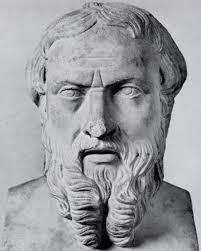 Herodotus
HerodotusIt may be that Herodotus misinterpreted the post mortum transformations of the dead (“Becoming a Hawk of Gold,” for example) as transmigrations of the soul. It may be that Diodorus and Plutarch, writing after Herodotus, just picked up his idea.
Empedokles, a contemporary of Herodotus, refers to “polluted daimons” who are forced to wander the world in many forms “changing one toilsome path of life for another,” though he does not refer to this as being an Egyptian conception. (Empedokles, Katharmoi)
In a number of his works, Plato mentions transmigration as punishment that souls suffer for bad deeds in life. The idea entered the Roman world as well. It can be seen in Virgil’s Aeneid, where reincarnation was seen as a reward for a good soul rather than a punishment for a bad one.
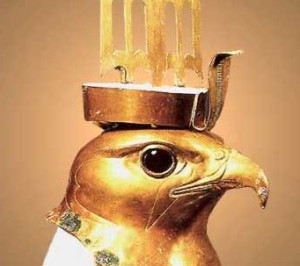 Becoming a Hawk of Gold
Becoming a Hawk of GoldFor the Egyptians, the transformations of the dead were simply part of an active and happy afterlife. The dead could become a hawk, a lotus, a serpent…and godlike. Louis Zabkar (an Egyptologist who made an important study of the Isis hymns at Philae) believes that this was a way of ensuring the ba of the person had unlimited freedom to come and go at will on earth and in the otherworld.
Several pharaohs took the name Repeater of Births, which sounds like a reference to reincarnation, but probably isn’t. For Seti I, it apparently meant that he intended to usher in an Egyptian renaissance of sorts. Or it may have referred to the pharaoh’s divine rebirths, which occurred at certain festivals of renewal, or to the the king’s connection to the Sun God Re Who is reborn daily.
All that said, I’d like to share with you one of my (possible?) past life stories.
During a vacation period a while ago, I had the luxury of frequent invocation of the Goddess. While working the Opening of the Ways ritual, I “saw” a flash of a scene that had a deju vu feeling about it, so I decided to follow up on that vision with Isis. Under Her wings, I traveled back in the Boat of Millions of Years to locate the life that included the scene that had touched me. Here is that tale…

A woman of about 20 is looking out across the Alexandrian harbor. Her name is Ankesphilia and she is the priestess of the Pharos, the Lighthouse of Alexandria. Her duty is to perform something like the Opening of the Ways ritual—but for the opening of the Alexandrian harbor and for fair, “open” weather. This is done within the Pharos itself, about halfway up the structure. That’s where the scene that first caught my attention is from: halfway up the Pharos, overlooking the harbor.
And while Isis is the Goddess of the Lighthouse, it is not Isis who is in Ankesphilia’s heart. Instead, it is her duty to the city that occupies her. Ankesphilia has almost no personal freedom and must stay on Pharos Island at all times, except when there are great festivals in the city. Then she may go to see the processions. I have the feeling that she was “given” or vowed to the Pharos, though it was not her own vow; perhaps her parents? In a way, it reminds me of the later Christian anchorites.
 An artist’s vision of the Pharos lighthouse of Alexandria
An artist’s vision of the Pharos lighthouse of AlexandriaThe priestess is from a wealthy, but not noble, family. Her parents own a shipping business, but now her father has retired to the priesthood and her mother runs the business. Her father sometimes visits Ankesphilia at the Pharos. She rarely sees her mother. She has two brothers, both in the military. Though she has had no choice in her fate, I sense no rebellion or resentment in her. I have the feeling she is perhaps not very well educated, bright, or curious. She simply does the duty that has been given to her without complaint and with conscientiousness.
Ankesphilia died in her 30s after contracting a disease that came into the harbor city from overseas.
And that’s it. Past life? Fantasy? I don’t know, but either way, it tells me something about myself.
__ATA.cmd.push(function() { __ATA.initDynamicSlot({ id: 'atatags-26942-60bd3e16a0ff4', location: 120, formFactor: '001', label: { text: 'Advertisements', }, creative: { reportAd: { text: 'Report this ad', }, privacySettings: { text: 'Privacy', } } }); });May 30, 2021
Isis the Lighthouse Goddess
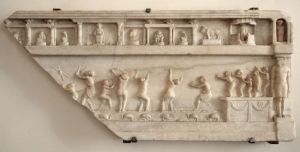 This scene is from a Roman tomb; some think it may be a scene from the Navigium Isidis, though I see no ship…
This scene is from a Roman tomb; some think it may be a scene from the Navigium Isidis, though I see no ship…As one of the most important Goddesses of the ancient seaport of Alexandria, Isis was closely associated with the sea. In that Greco-Egyptian city, She was known by the Greek epithet Pelagia, “of the sea.”
Across the Mediterranean from Alexandria, Roman Isiacs celebrated the festival of the launching of the ship of Isis, the Navigium Isidis, which marked the opening of the shipping season on the sea. It’s the festival described by Apuleius in his ostensibly fictional account of initiation into Isis’ Mysteries in The Golden Ass.
 This fresco, from the Temple of Isis in Pompeii, shows a mythic rendering of the Navigium. In the center, we see Isis in the boat on the right as She brings the floating (sarcophagus?) of Osiris with Her.
This fresco, from the Temple of Isis in Pompeii, shows a mythic rendering of the Navigium. In the center, we see Isis in the boat on the right as She brings the floating (sarcophagus?) of Osiris with Her.There is another epithet of Isis that connects Her with the sea, shipping, sailing, and the wind necessary for it. It is Pharia.
As Pharia, Isis is connected with the great lighthouse of Alexandria, one of the Seven Wonders of the Ancient World and a famous symbol of the city of Alexandria. The lighthouse was called the Pharos after the small island on which it stood. Due to the lighthouse’s fame, pharos eventually became a general term for “lighthouse.” (This persists even in modern languages; in Italian and Spanish, lighthouse is faro and in French, it is phare.)
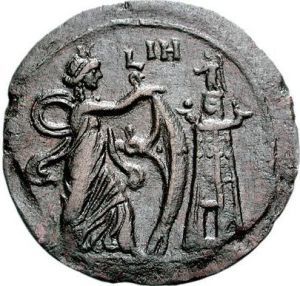 Isis Pharia with Her sail and the lighthouse on the right on an Alexandrian coin
Isis Pharia with Her sail and the lighthouse on the right on an Alexandrian coinIsis Pharia is Isis the Lighthouse Goddess. Alexandrian coins frequently represented the Goddess and the Pharos together.
Roman inscriptions attest to the existence of an Isis temple or shrine on the island, very close to the lighthouse itself. Between 1994 and 1998, archeological divers in the bay of Alexandria discovered a huge, red-granite torso of a woman, the base of an Isis statue, pieces of the Pharos itself, as well as the remains of a rock-cut temple that may very well be part of the temple of Isis Pharia.
 An artist’s vision of the Pharos lighthouse of Alexandria (Lighthouse by Lee Krystek)
An artist’s vision of the Pharos lighthouse of Alexandria (Lighthouse by Lee Krystek) There are several legends about how the Pharos island got its name. One says that when Menelaus was returning from the Trojan War, his ship was blown off course and landed on the island. Not knowing where he was, he asked the first Egyptian he saw. The man responded, “Per Aoh,” meaning that the island belonged to the pharaoh. (Pharaoh is the Greek corruption of an Egyptian term for king, Per Aoh, which means “Great House.”) Menelaus heard it as “pharos.”
Another story derives the name from that of Menelaus’ helmsman, Phrontis, who died on the island. In Greek, the word pharos refers to a cloth or sail. In accordance with this punning meaning, images of Isis Pharia show Her with a billowing sail in one hand while Her cloak is blown backwards over Her shoulder and the famous lighthouse stands in the background.
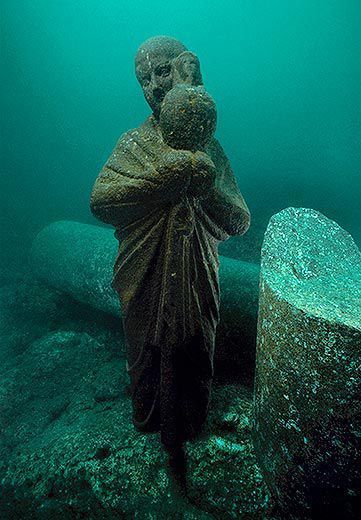 An Isis priest carrying the Osiris Hydreios, shaped like a canopic jar, underwater in the bay of Alexandria
An Isis priest carrying the Osiris Hydreios, shaped like a canopic jar, underwater in the bay of AlexandriaIn late legend, Isis was said to have invented the sail while searching for Her son, Horus. The early Christian writer Tertullian, writing against the Pagan religions, says that Pharia’s name “shows her to have been the king’s daughter,” (as opposed to being a true Goddess, of course). Tertullian is surely interpreting Pharia as a feminized version of pharaoh.
Just as the illumination of the Pharos lighthouse turned Alexandria’s dangerous seas and tricky harbors into commerce-friendly ports, the spiritual light of the Lighthouse Goddess served as a guide for humankind. Isis Pharia is the guardian of navigation and safe harbors—of ships and of souls.
May 23, 2021
Intrigue & Scandal in the Temple of Isis
Have you heard the shocking—shocking, I tell you!—tale of Paulina and Decius in the Roman Temple of Isis? No? Well, then, as a well-educated Isiac you must, you must. And I’m just the gossip to tell it to you. Here’s the tale, then I’ll join you on the other side for some discussion…
In Rome, in the 1st century CE, there lived a young, beautiful, and rich Roman matron of high birth named Paulina. She was modest, of a most virtuous reputation, and completely faithful to her husband, Saturninus. He, too, was noble and of the very highest character, in every way the equal of his wife. Everybody loved Paulina and Saturninus.

Paulina with pseudo-Anubis on the prowl; this art is by Fortunino Matania (1881-1963), Paulina in the Temple of Isis.
 A priest in the guise of Anubis; from the Temple of Isis in Pompeii
A priest in the guise of Anubis; from the Temple of Isis in PompeiiBut now, another man enters the scene to disrupt this ideal couple. Of high equestrian rank—we could call him a knight, he “fell in love” with Paulina. I put that in quotes because it was more like “powerfully lusted after,” as we shall see. His name was Decius Mundus and he simply had to have her. He sent gifts. Paulina returned them. He sent more gifts. She returned those, too. Finally—and who knows why he thought this was the way to go—he offered her the outrageous sum of 200,000 Attic drachmae for one night with her.
Predictably, she turned him down.
Drama queen that he was, Decius decided to starve himself to death for want of Paulina. Apparently, he talked about it endlessly.
One of Decius’ servants, a freed woman named Ide, devised a plot that she proposed to Decius. For a mere 50,000 drachmae, she was sure she could get Decius the woman he so histrionically desired. You see, Ide happened to know that Paulina was a devotee of Isis. While lavish gifts and money were not the way to her bed, perhaps religion was.
 Reconstruction of the Iseum Campense in Rome
Reconstruction of the Iseum Campense in RomeIde went to the Temple of Isis and bribed a couple of priests; 25k drachmae now, 25k when Decius succeeds. They agreed and immediately sent one of their number to Paulina. He told her Anubis had given him a message that He was in love with Paulina and wanted to dine and sleep with her. Paulina was flattered. She immediately told Saturninus what Anubis wanted. Apparently he was cool with it, too, so off Paulina went to the Temple of Isis.
Paulina was duly wined and dined without seeing pseudo-Anubis. Then the priests closed the temple and conducted Paulina to the sanctuary, where the lights were put out. Decius leaped out and under the cover of darkness had his way with Paulina. All. Night. Long.
She, rather pleased with the divine experience, went home and proudly told her husband and girlfriends all about it. Her girls were a bit skeptical given the nature of the thing. But since Paulina’s reputation was so immaculate, in the end, they had to believe her.
Three days later, Decius finds Paulina and, sneering at her, admits the whole plot and proves himself to be entirely the asshole we always knew he was. Paulina is pissed. She enlists her husband’s help and he goes straight to Emperor Tiberius. Tiberius has the matter investigated. Eventually the guilty priests and Ide are crucified. The Temple of Isis is razed to the ground. Isis’ sacred image is tossed into the Tiber. And Decius? Merely banished. It was a crime of passion, after all.
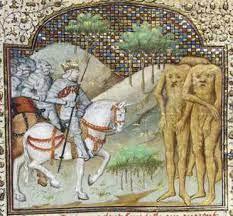 From this Medieval illustration of the tale, you can see that the Alexander Romance is not, well, entirely historical
From this Medieval illustration of the tale, you can see that the Alexander Romance is not, well, entirely historicalWell.
As you can see, this story has almost nothing to do with Isis, except for the venue, some lowlife priests, and, of course, Paulina’s devotion. Aside from its tragicomic-erotic nature, the Paulina story is famous mostly because of the entry right before it in a particular book. The book is Antiquities of the Jews by Flavius Josephus. Josephus’ book is held up as an early source for a historical mention of a certain Jesus, the Christ. (Josephus was ostensibly writing history, so it’s an important mention.) Naturally, there is controversy over whether this is an authentic historical record of Jesus or a later addition by zealous Christians.
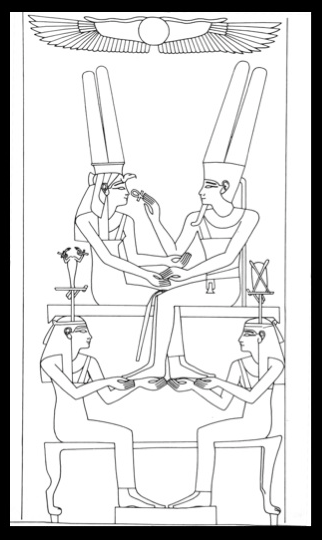 Ahmose and Amun conceiving Hatshepsut; pretty tame, eh?
Ahmose and Amun conceiving Hatshepsut; pretty tame, eh?Interestingly, the same has been said about the Paulina story. Some have called it a fabrication by Josephus to explain the real persecution of the Jews and the Isiacs by Tiberius in 19 CE. Others say that the gullibility of both Paulina and Saturninus seems more like the plot of a farce than reality. And indeed, there are several similar fictional tales. In the Roman playwright Plautus’ play Amphitryon, Jupiter is sleeping with Amphytryon’s wife, Alcmena, in the guise of her husband. A tricksy slave—who is really Mercury in disguise—confuses things in support of Jupiter’s lustful cause. After some romantic comedy twists, all is well and Amphytryon is okay with sharing his wife with a God.
Then there is the Alexander Romance, which is a highly fictionalized biography of Alexander the Great. Though we mostly know it from Medieval texts, the original has been dated by experts to anywhere from the 3rd century BCE to the 4th century CE. In this story, the Egyptian pharaoh, Nectanebo (both Nectanebo I and II were builders of Isis’ temple at Philae), is also a mighty magician. Basically, he seduces Alexander the Great’s mother, Olympias, by magic, convincing her that she is sleeping with the God Ammon (Amun). Hence the tale that Alexander is a true Egyptian pharaoh by virtue of his Divine father.
MinIt seems likely that the expulsion of the Jews and the Isiacs in 19 CE (as well as other times in Roman history) was more of a political move than retribution for offenses against a Roman matron. During times of internal turmoil, the emperors would stir up the Romans against outsiders (foreign religions, oh my!) and then there would be expulsions or restrictions of some kind. A juicy sex scandal could be the perfect excuse. (For a broader look at Isis in Rome, go here.) On the other hand, it should be noted that Isis devotees in Rome were more known for their religious abstention from sex during periods known as the Chastity of Isis, and not for their licentiousness.
But let’s get back to our sex scandal…
As most of you know, in Egyptian tradition, one did not have temple sex, sacred or otherwise. On the other hand, Egyptian queens did have sex with Gods to produce future kings; it was part of the royal lore. Hatshepsut claimed Amun as her father, the God having come to her mother Ahmose in the form, no doubt, of her father Thutmose I. And Greek and Roman tales have plenty of Divine-human sexual encounters. Hercules is the result of the lovemaking of Jupiter and Alcmene in the play mentioned above.
 Sex on a kline with Anubis?
Sex on a kline with Anubis?I’m reading a paper by a scholar, David Klotz, who thinks that sex with Deities may have indeed been going on in temples of the Egyptian Deities during the Roman period. He starts his argument with a tomb painting from El-Salamuni, near Akhmim. Akhmim was known as Koptos to the Greeks. El-Salamuni has a rockcut chapel to Min. Isis and Min were worshipped together at Koptos. As you may recall, Min is the God with the very upright phallus.
So that I do not leave you in suspense, have a look at the tomb painting here. You should be able to click for a larger image. Based on other representations of Anubis in the tomb, they think the naked fellow with the woman on the couch is Anubis as well. Frankly, I can’t quite tell because the head is so destroyed. You?
Klotz mentions that jackals had a reputation for randyness and that an Egyptian dream manual counts it a good omen if a man dreams of his wife having sex with a jackal. In one of the many papyri found in the Oxyrhynchus (Egypt) cache, was an invitation “to dine at the banquet of the Lord Anubis in the oikos [household] of the [probably] Serapeum.” There are also some known stele, funerary in nature, that feature what appear to be dinner and drinking parties taking place with an image of Anubis in the room with the partiers. In some of them, a couple of people are nude or partially nude.
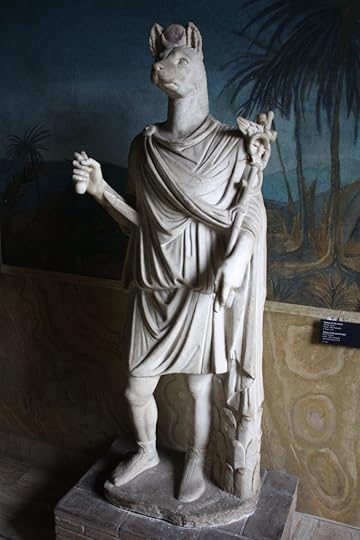 Anubis (Hermanubis) in Roman dress
Anubis (Hermanubis) in Roman dressThere is also a spell in the magical papyri (PGM) in which the magician first invokes Anubis, then asks Him bring the local Deities in. Anubis sets up a banquet table for Them, entertaining them until one of the Deities is willing to give an oracle. Anubis is also invoked in some of the non-consensual “love” spells in the magical papyri. At Saqqara, the mudbrick Bes chambers, which featured large images of Bes with smaller images of naked women and in which erotic terracotta votive statues were found, were located in the precinct of Anubis. It is likely that women came there seeking fertility. We don’t know, but it is possible that priests in Godform helped Bes (Anubis?) out in cases like this.
Finally, there are references in Roman literature that connect Anubis with sexy doings. One is the name of a popular farce called The Adulterous Anubis. The other is one of Juvenal’s satiric poems that says priests in the guise of Anubis were the ones who interceded for wives who had not managed to maintain the Chastity of Isis…for a nice bribe, of course.
Klotz concludes that perhaps there was a tradition of priests dressed as Anubis having sex with women in a temple, likely in a quest to conceive a child. So it may be that the fiction of the Paulina story had some kernel of truth—even if the story as a whole does not.
And, you know…maybe. There is a story from the late Pagan period that a couple went to the temple of Isis and actually did come away with a child; a priestess allowed them to adopt her own child. All kinds of propagandistic hay was made over that incident. But it meant that people did continue to come to Isis in a desire for children. And—one way or another—it did happen.



